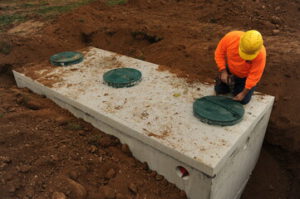A septic tank is a sealed container that collects and filters waste water. Sewage from toilets and sinks flows into the tank, where solids settle and filtered liquids flow out to a drain field.

A septic system is an excellent choice for homeowners who live in rural areas or where a city sewer line is not available. However, there are a few things you should know before installing one.
Septic tank installation costs depend on a variety of factors. The size of your septic tank, the type of material used to build it, and the location of your home will all influence the price you pay.
The most common material for septic tanks is concrete. This material is relatively cheap to install and does not rust or crack easily. It is also relatively durable and long-lasting.
Another type of septic tank is made of fiberglass. This material is a bit more expensive than concrete but can last longer and will not deteriorate in the same way as concrete does.
In addition to the septic tank itself, you may also need a pump and cesspool, depending on the system you choose. These two additional components add cost and complexity to the project.
Before septic tank installation, you will need to have the property checked for percolation and drainage. This will help the septic installer design a system that will function properly.
Once the site has been checked, a permit must be obtained. This usually takes a few weeks and costs $250–450.
When comparing prices, it is important to consider the size of your home and how many people will be living in it. The larger your home is and the more people who live in it, the more expensive your septic system will be.
Choosing the wrong type of septic tank is also an easy mistake to make. If you buy a tank that is too large for your home, it will overflow, and sewage will back up into the house.
One of the most important things to consider is the type of soil on your property. If the soil is heavy with clay or very rocky, it can be more difficult to create a septic system.
It is also worth considering the local water table. Septic systems are most effective when they are located at least 3–4 feet above the water table.
If you are planning on replacing your septic system, be sure to get multiple estimates from local companies. This will help you determine which company offers the best materials and the most reasonable timeline for your project.
Septic tank installation can be an expensive project, but if you’re careful about your choices and keep up with maintenance, your system should last for years. The type of material used for your septic tank plays a big role in how long it will last and how well it works.
Fortunately, there are many different types of materials that can be used to make septic tanks, including concrete, fiberglass, and plastics. Each has its own unique benefits and drawbacks, so it’s important to choose the right one for your property.
Concrete septic tanks are a popular choice because they’re strong and durable. However, they can be susceptible to settling and earthquakes. Additionally, they’re easily damaged by sewage gases.
Fiberglass septic tanks are another popular option because they’re strong and durable but don’t crack or rust. They also tend to be lighter than concrete, so they’re easier to install.
They cost $1,200 to $2,000 on average, not including installation. Those costs include labor, materials, and any necessary permits.
To start, you’ll need to dig a pit near your house that’s at least a foot wide and deep. The pit should slope away from the foundation of your home and into the septic tank by about 1 inch every 50 feet as you dig.
Next, you’ll need to create a trench that extends from the pit into the septic tank. This trench should be at least a foot wide and deep, and it should be laid out on a level surface.
Once the trench is ready, you’ll need to line it with 4-inch-diameter pipe. This will allow the septic effluent to flow from the tank to the absorption field.
A septic tank should be pumped annually to remove the buildup of sludge and scum at the bottom of the system. This removes excess waste and slows down bacterial action in the tank.
